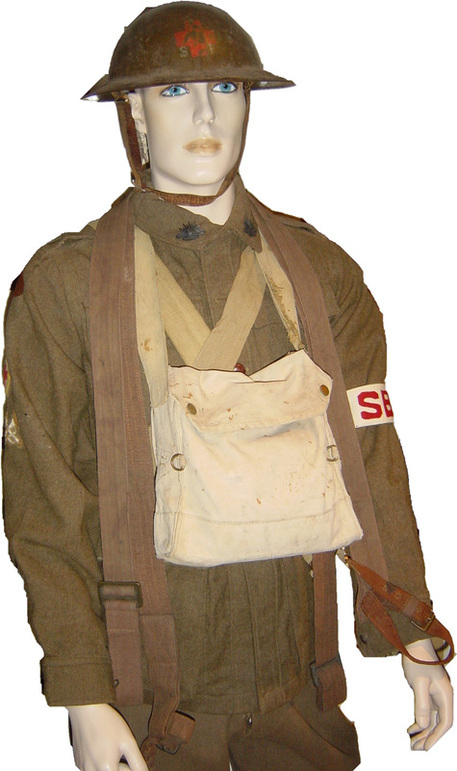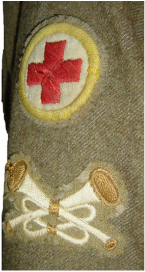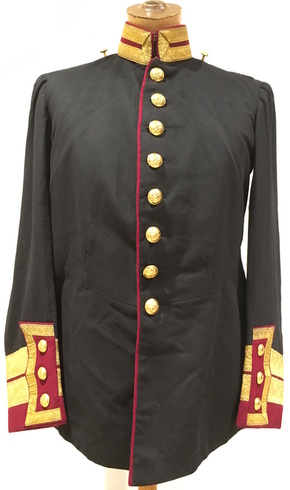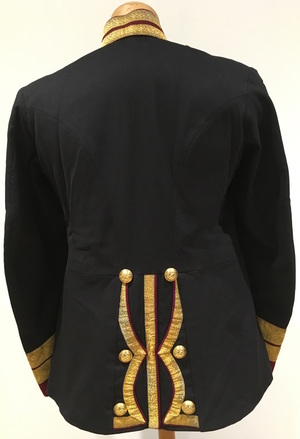World War one
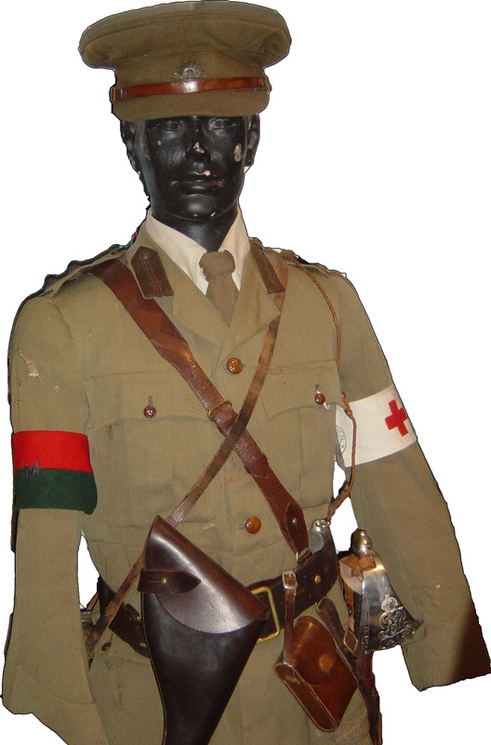
WW1 Australian Medical Staff Officer
This is the uniform of a Medical Staff Officer with the rank of Lieutenant, which was tailored in Adelaide in 1914. The Medical Staff Officer would be posted to an Army Head Quarters position to provide administrative assistance to the Director of Medical Services.
The officers visor cap is of barathea cloth which was very typical of the 1st Australian Imperial Force (AIF). It has a thin brown leather chin strap held at the sides by small leather plaited buttons, and a metal Australian Rising Sun badge is affixed to the front.
The khaki gabardine wool tunic is open collar and has four pockets - two upper box pleated breast pockets with scalloped flaps and two lower larger patch pockets with straight flaps. Both sleeves have an inverted 'V' cuff.
All the buttons are of pressed plaited leather extending down the front of the tunic, the pockets, and to both epaulettes.
The two epaulettes on the shoulders display his rank - having two metal pips indicating lieutenant, and the metal AUSTRALIA shoulder titles.
On either side of the collar are two gorgets of chocolate brown wool cloth having a central line of brown silk gimp, each terminating in a small metal Australia button. Gorgets indicated that he was a Staff Officer. Chocolate brown was the colour that designated the Australian Army Medical Corps from 1903 to 1931 (from 1931 onwards the colour was changed to Dull Cherry).
There are two brassards - One on the right arm being a Red over Green woollen brassard with a gilt wire embroider 'M' which signifies that he is a Medical Staff Officer; and one on the left arm which is a white cotton brassard with a sewn red wool Geneva cross. The wearing of a red cross brassard was instituted by the Geneva Convention in 1906. This indicated that he is a non-combatant and was afforded and entitled to protection from harm under International Law.
A brown leather Sam Brown belt is worn with a Webley revolver and holster, sword frog and 1897 Infantry Officer's Sword, and a camera slung on the belt. Medical personnel are permitted to be armed with light weapons for the purposes of self defence and the maintenance of order. A silver plated whistle on a brown leather plated lanyard and a water bottle resting on his right hip are slung over the left shoulder.
Light khaki Bedford cord jodphurs and knee length officer's brown leather boots complete the ensemble.
This is the uniform of a Medical Staff Officer with the rank of Lieutenant, which was tailored in Adelaide in 1914. The Medical Staff Officer would be posted to an Army Head Quarters position to provide administrative assistance to the Director of Medical Services.
The officers visor cap is of barathea cloth which was very typical of the 1st Australian Imperial Force (AIF). It has a thin brown leather chin strap held at the sides by small leather plaited buttons, and a metal Australian Rising Sun badge is affixed to the front.
The khaki gabardine wool tunic is open collar and has four pockets - two upper box pleated breast pockets with scalloped flaps and two lower larger patch pockets with straight flaps. Both sleeves have an inverted 'V' cuff.
All the buttons are of pressed plaited leather extending down the front of the tunic, the pockets, and to both epaulettes.
The two epaulettes on the shoulders display his rank - having two metal pips indicating lieutenant, and the metal AUSTRALIA shoulder titles.
On either side of the collar are two gorgets of chocolate brown wool cloth having a central line of brown silk gimp, each terminating in a small metal Australia button. Gorgets indicated that he was a Staff Officer. Chocolate brown was the colour that designated the Australian Army Medical Corps from 1903 to 1931 (from 1931 onwards the colour was changed to Dull Cherry).
There are two brassards - One on the right arm being a Red over Green woollen brassard with a gilt wire embroider 'M' which signifies that he is a Medical Staff Officer; and one on the left arm which is a white cotton brassard with a sewn red wool Geneva cross. The wearing of a red cross brassard was instituted by the Geneva Convention in 1906. This indicated that he is a non-combatant and was afforded and entitled to protection from harm under International Law.
A brown leather Sam Brown belt is worn with a Webley revolver and holster, sword frog and 1897 Infantry Officer's Sword, and a camera slung on the belt. Medical personnel are permitted to be armed with light weapons for the purposes of self defence and the maintenance of order. A silver plated whistle on a brown leather plated lanyard and a water bottle resting on his right hip are slung over the left shoulder.
Light khaki Bedford cord jodphurs and knee length officer's brown leather boots complete the ensemble.
|
WW1 Australian Medic / Stretcher Bearer
This is the uniform of a Medic with the rank of Private on the Western Front in France in 1917. A Medic's job was to provide initial first aid to injured soldiers and remove them from the battle field by stretcher to rear echelon medical facilities. This was a very hazardous job, often under fire. The khaki painted Mk 1 Brodie helmet has a painted red cross to the front and small white 'S' and 'B' (Stretcher Bearer) letters painted either side of the cross. The red cross indicates to the enemy his non-combatant role. The Australian pattern 1914 khaki twill weave woollen tunic has a closed collar with metal Australian Rising Sun badges secured at each end. There are two pleated upper breast pockets and two lower larger pockets. An integrated belt of the same twill cloth is at waist level with a small square brass buckle at the front. Two epaulets have in subdued metal 'AMC' for Army Medical Corps. All the buttons are of pressed plaited leather extending down the front, the cuffs, and to the two epaulettes. A chocolate brown oval cloth badge of the 10th Australian Field Ambulance is sewn to both upper sleeves. Below this on the right sleeve only is a worsted Geneva Cross within a yellow circular border, all in thick thread. Below this on the right sleeve only is a Proficiency Badge of a Trumpeter. Many AIF units had buglers or trumpeters to sound out orders. Around his neck is a WW1 issued gas mask bag with gas mask and two stretcher bearer web belts. The gas mask bag was worn to the front for quick access in gas attacks so that the mask could be slipped over the head in short order. A stretcher bearer web belt was used by Medics and Stretcher Bearers to help distribute the weight of the stretcher, with it's wounded soldier, across the shoulders. This was achieved by placing the stretcher handles into loops at both ends of the web strap. On the left sleeve is a white cloth brassard with the letters in red wool 'S' 'B' for Stretcher Bearer. Slung over the right shoulder is a medical haversack with shell dressings that is resting on the left hip. Slung over the left shoulder is another haversack for personal affects. The khaki wool whipcord cloth breeches are held up by suspenders and have a button fly. Wool putties and brown leather ankle boots complete the ensemble. |
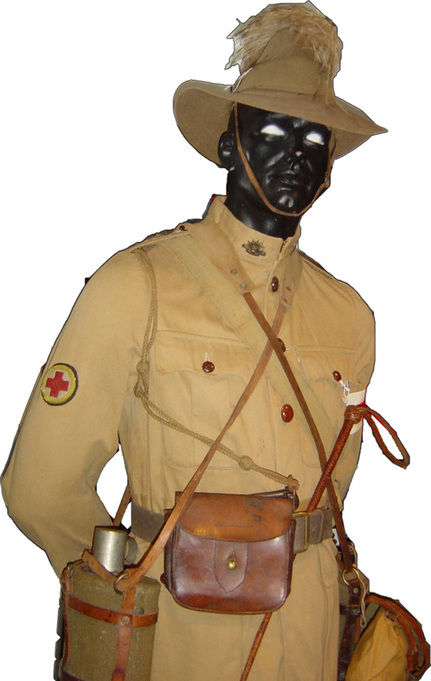
WW1 Light Horse Medic
This is a Medic in the Australian Light Horse in the Western desert in 1917. The highly mobile Light Horse required equally mobile supporting units such as the Australian Medical Corps to keep pace. The Australian Light Horse charge at Beersheba and the ride into Palestine are their hall marks and the Australian Light Horse Medical elements accompanied them.
The iconic Australian Slouch Hat has a khaki pugaree around the crown and inserted behind this on the left hand side are Emu feathers. A large metal Australian Rising Sun budge is affixed under the left brim. The internal leather sweat band is maker marked and dated 1916.
The sandy coloured cotton drill tunic has a high closed collar with two metal Australian Rising Suns secured at either end. There are two pleated breast pockets with scalloped flaps.
Two epaulets have metal 'LH' for Light Horse and 'FA' for Field Ambulance.
All buttons are plaited leather extending down the front, the two pockets and the two epaulettes.
On the right sleeve is the worsted Medic Trade Badge and on the left sleeve is the white cotton brassard with the red Geneva cross.
A 1915 pattern brown leather belt with a large brass buckle is worn around the waist. On the belt is a large leather Medic pouch containing first aid supplies. A plaited brown leather ridding crop is thrust through the belt.
Slung over the right shoulder is a medical haversack resting against the left hip. This contains larger medical items such as large compression bandages and splinting material. A lanyard is also around the right shoulder which has the Light Horse multi tool at it's end (just visible behind the pouch.
Slung over the left shoulder is the special Medical Water Flask resting against the right hip with it's cup. This metal water flask was much larger than the standard water flask in order to contain an adequate quantity of water to quench the thrust of multiple wounded soldiers.
Sandy coloured drill cotton breeches, brown leather gaiters and brown leather ankle boots complete the ensemble.
This is a Medic in the Australian Light Horse in the Western desert in 1917. The highly mobile Light Horse required equally mobile supporting units such as the Australian Medical Corps to keep pace. The Australian Light Horse charge at Beersheba and the ride into Palestine are their hall marks and the Australian Light Horse Medical elements accompanied them.
The iconic Australian Slouch Hat has a khaki pugaree around the crown and inserted behind this on the left hand side are Emu feathers. A large metal Australian Rising Sun budge is affixed under the left brim. The internal leather sweat band is maker marked and dated 1916.
The sandy coloured cotton drill tunic has a high closed collar with two metal Australian Rising Suns secured at either end. There are two pleated breast pockets with scalloped flaps.
Two epaulets have metal 'LH' for Light Horse and 'FA' for Field Ambulance.
All buttons are plaited leather extending down the front, the two pockets and the two epaulettes.
On the right sleeve is the worsted Medic Trade Badge and on the left sleeve is the white cotton brassard with the red Geneva cross.
A 1915 pattern brown leather belt with a large brass buckle is worn around the waist. On the belt is a large leather Medic pouch containing first aid supplies. A plaited brown leather ridding crop is thrust through the belt.
Slung over the right shoulder is a medical haversack resting against the left hip. This contains larger medical items such as large compression bandages and splinting material. A lanyard is also around the right shoulder which has the Light Horse multi tool at it's end (just visible behind the pouch.
Slung over the left shoulder is the special Medical Water Flask resting against the right hip with it's cup. This metal water flask was much larger than the standard water flask in order to contain an adequate quantity of water to quench the thrust of multiple wounded soldiers.
Sandy coloured drill cotton breeches, brown leather gaiters and brown leather ankle boots complete the ensemble.
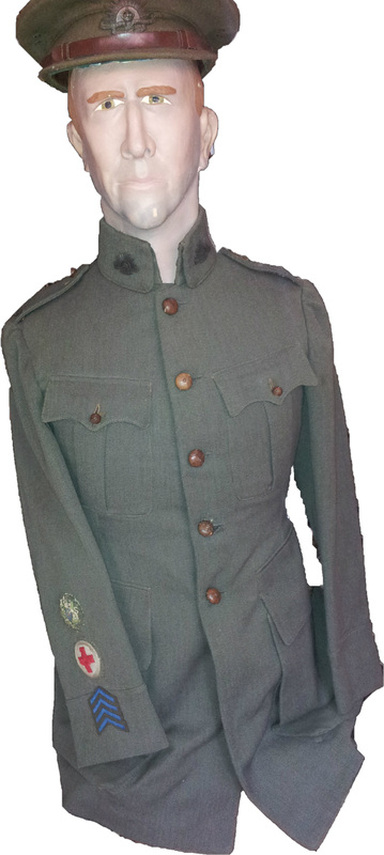
WW1 Warrant Officer Class 1 Australian General Hospital, Western Front, France 1918.
This is a senior Non-Commissioned Officer (NCO) tunic, with the rank of Warrant Officer Class 1 (WO1).
The Service Peak Cap is made from Officers quality doeskin wool fabric, having a brown leather chin strap and a large metal Australian Rising Sun badge affixed to the front.
The tunic is a 1912 Pattern Service Dress, tailor made in France during the First World War and was commonly favoured by Senior NCOs. It is made of fine grade woollen twill, having a high stand-and-fall collar with small metal Australian Rising Sun badges secured at each end, two box pleated breast pockets with scalloped flaps, and two lower large bellows pockets with straight flaps.
Two epaulets have a small metal AUSTRALIA title - this smaller version of the standard title was mostly used by Nursing Staff.
The quality of this tunic befits a senior NCO.
All buttons are pressed plaited leather which extend down the front of the tunic, all four pockets and to both epaulets.
A cotton worsted WO1 badge is sewn to the lower right sleeve, below this is the Medic Trade badge consisting of a thick worsted thread red Geneva Cross within a circle, and below that are four Over Seas Stripes indicating four years active service away from Australia.
Trousers of the same cloth and knee high brown leather boots complement the ensemble.
This is a senior Non-Commissioned Officer (NCO) tunic, with the rank of Warrant Officer Class 1 (WO1).
The Service Peak Cap is made from Officers quality doeskin wool fabric, having a brown leather chin strap and a large metal Australian Rising Sun badge affixed to the front.
The tunic is a 1912 Pattern Service Dress, tailor made in France during the First World War and was commonly favoured by Senior NCOs. It is made of fine grade woollen twill, having a high stand-and-fall collar with small metal Australian Rising Sun badges secured at each end, two box pleated breast pockets with scalloped flaps, and two lower large bellows pockets with straight flaps.
Two epaulets have a small metal AUSTRALIA title - this smaller version of the standard title was mostly used by Nursing Staff.
The quality of this tunic befits a senior NCO.
All buttons are pressed plaited leather which extend down the front of the tunic, all four pockets and to both epaulets.
A cotton worsted WO1 badge is sewn to the lower right sleeve, below this is the Medic Trade badge consisting of a thick worsted thread red Geneva Cross within a circle, and below that are four Over Seas Stripes indicating four years active service away from Australia.
Trousers of the same cloth and knee high brown leather boots complement the ensemble.
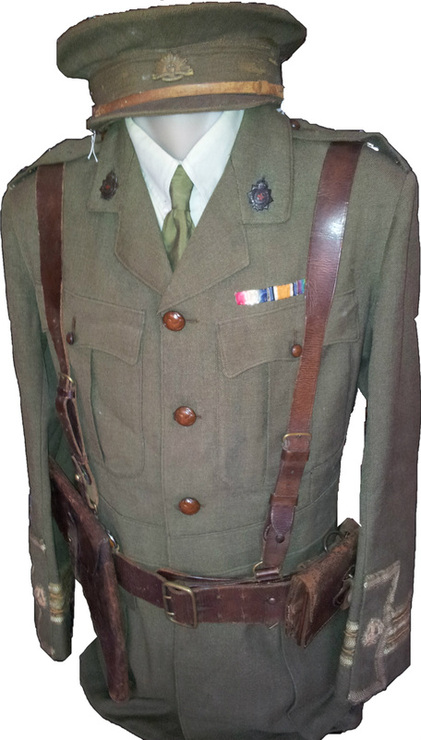
Pre First World War Australian Army Medical Corps Officers Tunic.
This is an Officer's pre-war cuff rank tunic, with the rank of Major. This was worn in the early part of the First World War.
The Officer's Service Peak Cap is khaki wool cloth with a narrow brown leather chin strap, and a brass Australian Rising Sun badge affixed to the front of the cap.
The tunic is of khaki wool serge with an open collar, having two 1906 pattern Australian Army Medical Corps badges attached to the collars. Their are two box pleated breast pockets with scolloped flaps and two lower bellows pockets.
All buttons are pressed leather that extend down the front of the tunic, all four pockets, and the two epaulets.
Two epaulets have metal 'AAMC' (Australian Army Medical Corps) shoulder titles.
The brown leather Sam Brown belt has the early twin shoulder straps. Attached to the belt is a small pouch of ammunition and a Webley holster.
Bedford cord jodhpurs and knee high brown leather boots complete the ensemble.
This is an Officer's pre-war cuff rank tunic, with the rank of Major. This was worn in the early part of the First World War.
The Officer's Service Peak Cap is khaki wool cloth with a narrow brown leather chin strap, and a brass Australian Rising Sun badge affixed to the front of the cap.
The tunic is of khaki wool serge with an open collar, having two 1906 pattern Australian Army Medical Corps badges attached to the collars. Their are two box pleated breast pockets with scolloped flaps and two lower bellows pockets.
All buttons are pressed leather that extend down the front of the tunic, all four pockets, and the two epaulets.
Two epaulets have metal 'AAMC' (Australian Army Medical Corps) shoulder titles.
The brown leather Sam Brown belt has the early twin shoulder straps. Attached to the belt is a small pouch of ammunition and a Webley holster.
Bedford cord jodhpurs and knee high brown leather boots complete the ensemble.
|
1935 Medical Generals Dress Tunic
This is an officers tunic with the rank of General. The tunic is made of super fine black melton cloth with the Medical Corps colour of dull cheery melton cloth to the collar & cuff facings and front seam piping. Gold ribbon lace decorates the collar, cuffs and rear skirt. Eight General's crossed sword & batton buttons secure the front, with six buttons and three to each cuff as decorations. |
|
1905. Officer's Mess Dress.
Light chocolate brown shell jacket with dark chocolate brown collar, cuffs and epaulettes. Rank displayed on the epaulettes. long trousers with a chocolate brown seam. |
|
